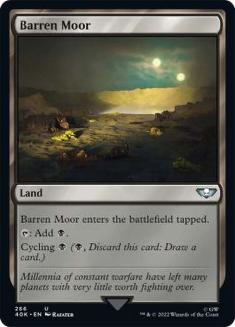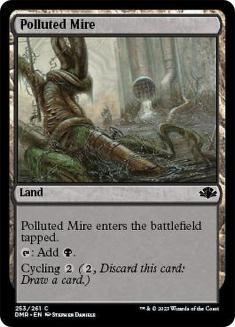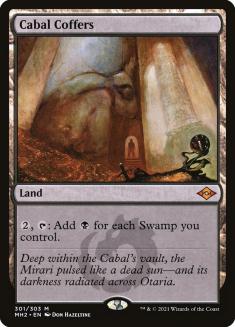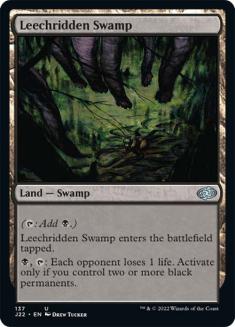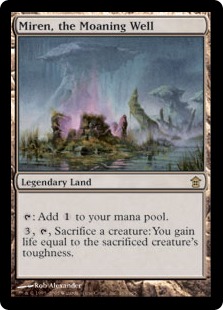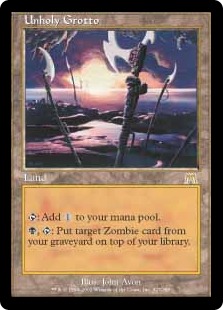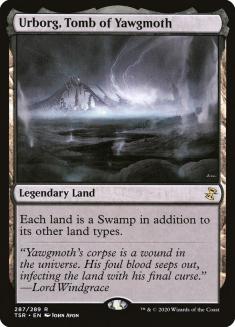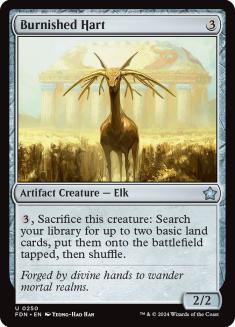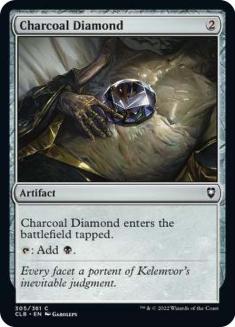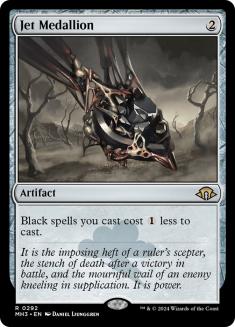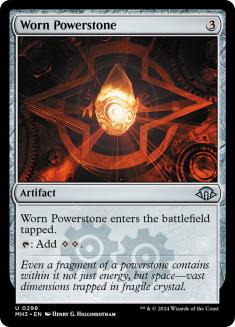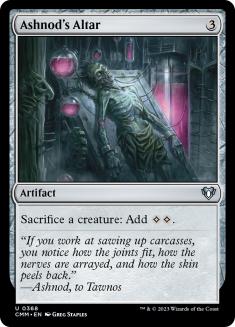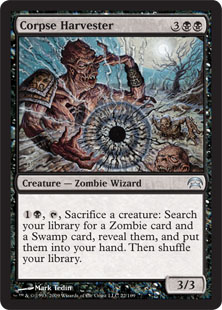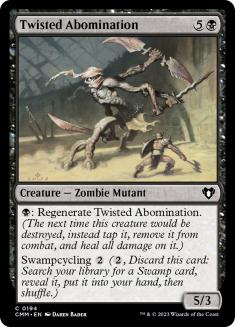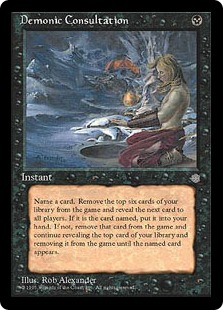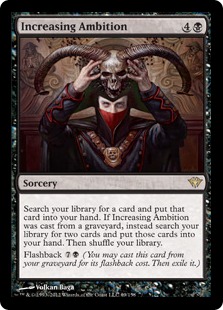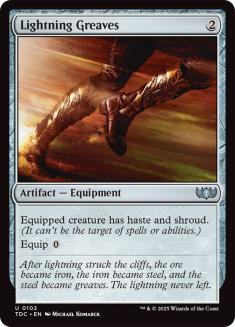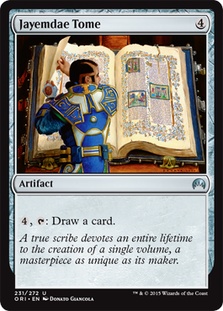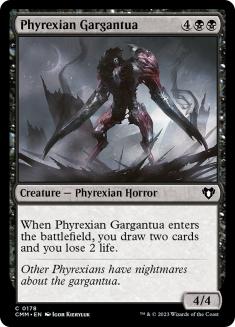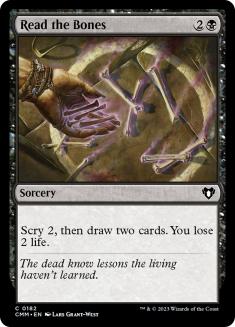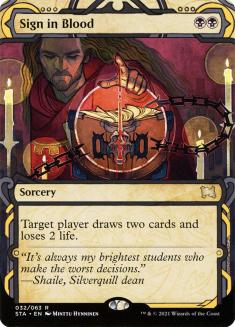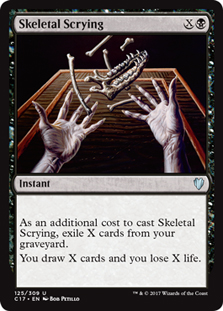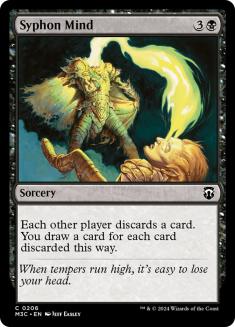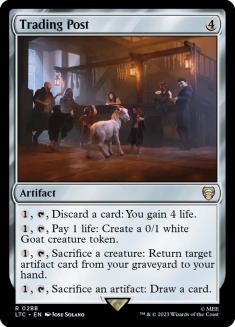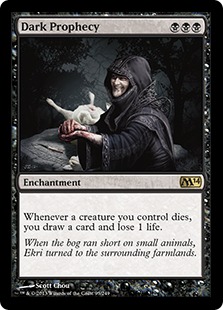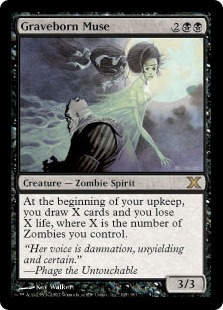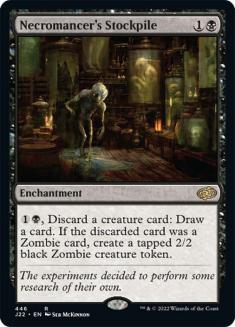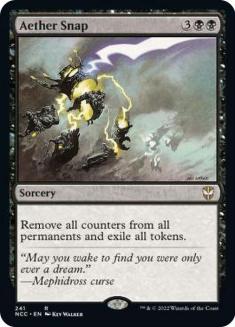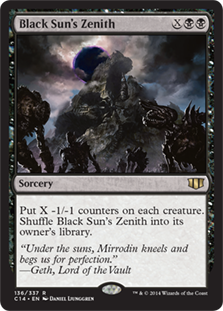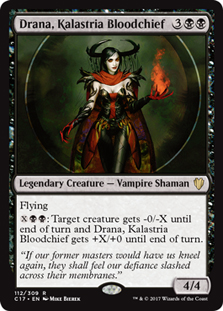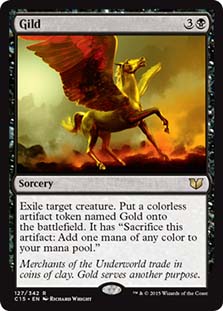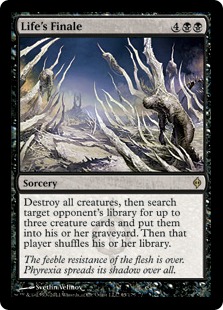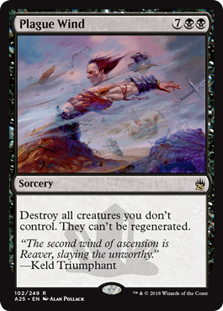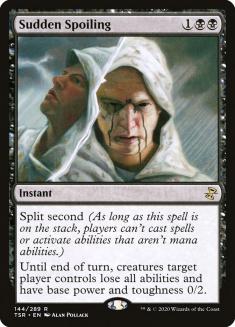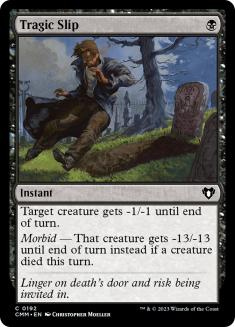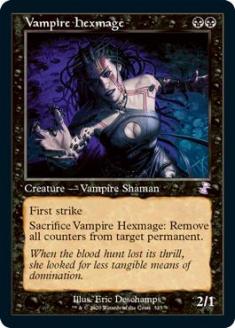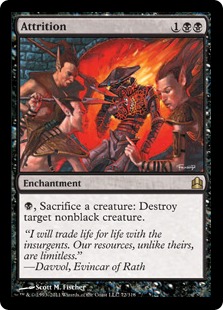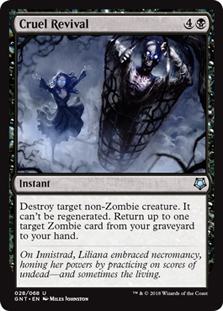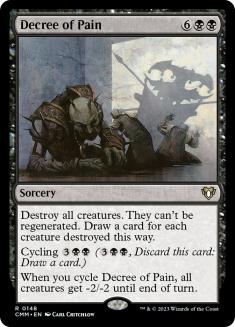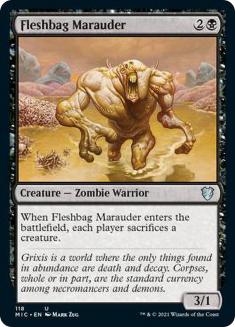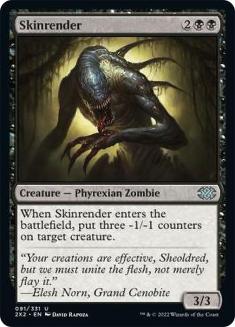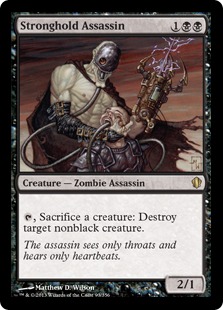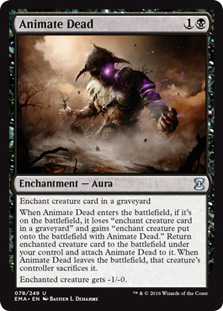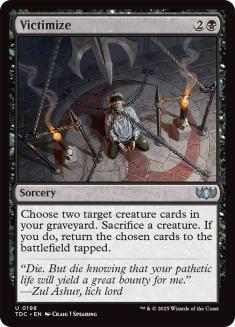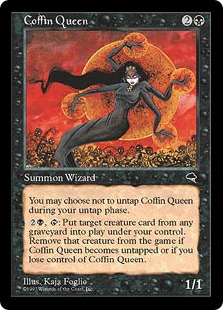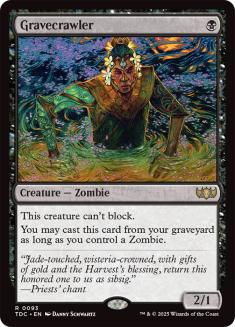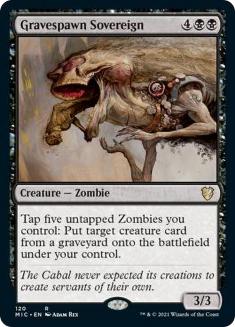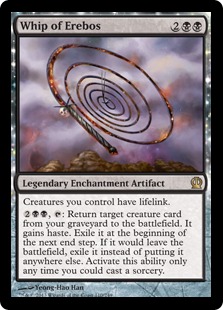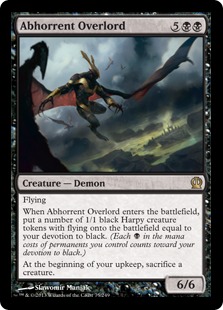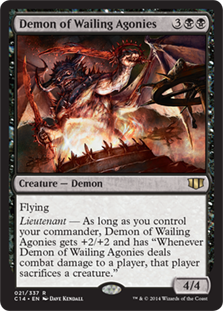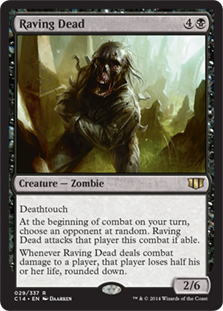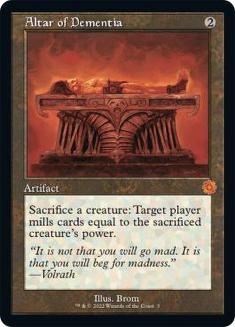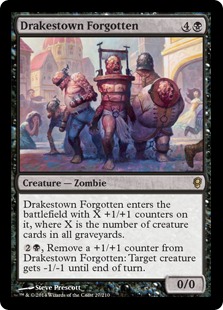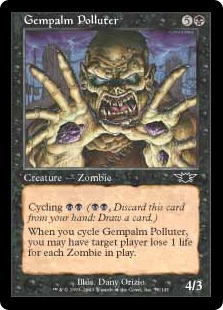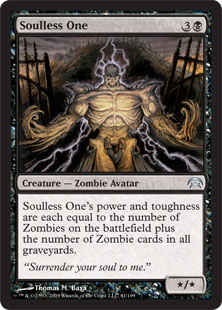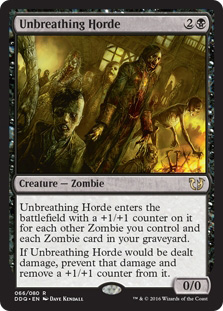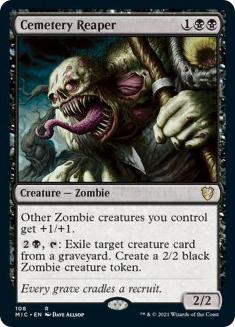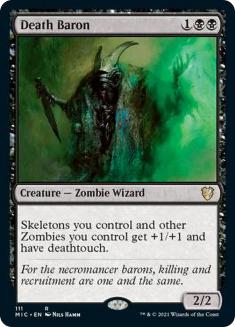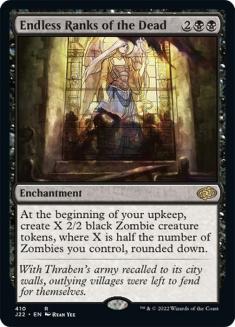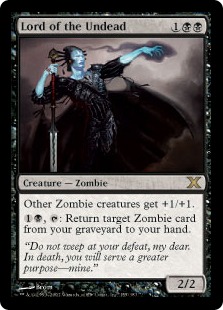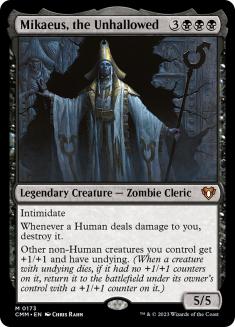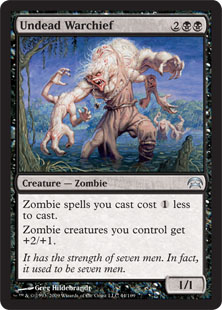Spice up your life, people! This week’s submission focuses on one of the more straightforward commanders from the Commander 2014 precon product: Ghoulcaller Gisa. Or Wednesday Addams, as I’ve been calling her. She’s a force multiplier with a reasonable body and a flavorful ability. She does a lot of what Black wants to be doing, and for this reason she’s a great introductory commander for newer players who are still getting used to the thrill of doing something degenerate.
That’s what guided me when I picked out this week’s letter, and it’s a winner! Adam and E, come on down!
|
Hello, Dear Azami!
In response to your call for C14 Commander decklists, I come to you with a challenge. My girlfriend, E, has just learned how to play Magic and decided she
E has expressed a strong desire for cheaper and more guys in the deck to feed Gisa. She likes destroying things (which is why Spine/Tribute/Plague Wind
Ideally, the deck would be straightforward, but with room to grow and some more complex lines of play available for her to find. Our total budget for this If you’re willing to help my Ghoulcaller girlfriend, it’d be awesome! Commander: Ghoulcaller Gisa 27 Swamp ~Adam & E |
From the very beginning of my Magic career, I’ve been a fan of black. It’s the most flavorful color in many ways, because most black spells have a cost.
Force of Nature’s upkeep cost never really tickled my fancy, since it was hard to see the connection between this natural monstrosity and four green mana
symbols, but Lord of the Pit? I always envisioned that dude as the demon from Fantasia, sitting atop his mountain, demanding tribute before quieting down
when his conditions were met.
I can only imagine how great it must feel when your first experience with black magic involves shambling legions of the undead. When I began playing, the
most amusing thing I ever managed to do was combine Nettling Imp, Sorceress Queen, and Sengir Vampire; we didn’t have the tools to go wide like black has
today.
So let’s go wide. If you like winning with hordes of zombies, E, let’s give you a few more ways to make your zombies, as well as some force multipliers to
make them stronger. And to help develop your understanding of the complexity available in this crazy game, let’s bring in some more multi-function cards in
place of some of the powerful, but narrow, cards you were currently included.
Plus, it’s Ghoulcaller Gisa we’re talking about, so let’s also lean into the tribal elements a bit harder. One of the neatest things about Magic is how the
creature typeline actually matters in many situations; while I can’t promise you that it’s going to ever be relevant that Burnished Hart is an elk, zombies
are one of the more developed tribes, and there are a bunch of old tools that get opened up because of that shared identity.
Shall we begin?
Lands
Out
(5):
In
(5):
Just to begin, let me reassure you about my reading comprehension skills. I saw your comments about considering Cabal Coffers and Urborg, Tomb of Yawgmoth,
but I also saw that your budget for this deck was $100. I made a point of tallying up the rest of the changes before seeing that there was room for those
two cards, and since there was (final budget being $100.45, which seemed close enough), now might be a good time to bring them in. You can certainly play a
mono-black deck without these tools, but they are fun! Plus, you can always save them for a rainy day, and stick with 27 swamps.
I cut Polluted Mire, Everglades, and Barren Moor because having Swamps seemed more important than the occasional extra value you get from those lands. Even
without Cabal Coffers there’s still Magus of the Coffers and Crypt Ghast serving as doublers (and, down the line, you might want to consider Liliana of the
Dark Realms, Lake of the Dead, and Nirkana Revanant, three more black cards that highlight black’s “big mana” theme; you can also invest in Gauntlet of
Power and Caged Sun, artifacts that do much of the same thing).
Unholy Grotto and Miren, the Moaning Well both came in because they’re good examples of the extra value you can get from your lands. Neither provides card
advantage, but they do provide action. Unholy Grotto gives you card selection through letting you loop any zombie from your graveyard to the top of your
library. Miren does a passable impression of High Market, trading an additional three mana to activate for what will occasionally be a sizeable chunk of
life.
Utility lands are solid because they advance your gameplan without taking up precious spell slots. And given the relative dearth of land destruction in
most polite Commander circles, usually your land will only get bombed if you’re using it to the point of it becoming a major threat.
Ramp
Out
(4):
In
(3):
I took out some good cards in this section, but these are the tough decisions one has to make when putting together a Commander deck. In general,
mono-black decks are able to skimp a little on their mana generation, since they tend to run doublers. While you’re not all-in on the doubling effects,
your mana curve doesn’t really require the full complement, nor does it require so many additional mana rocks. You should be set with Commander’s Sphere,
Mind Stone, and Unstable Obelisk, since each one of those can be utilized or cashed in should you ever flood out. And in general, unless a deck is planning
to cast a lot of cheap colored spells with at least one colorless mana in its cost, I tend to be a bit skeptical of the utility offered by the Medallion
cycle.
The three cards I brought in show some of the complexity that comes when you let multi-purpose cards fill in for stronger, single purpose versions of the
underlying effect. Twisted Abomination, for example, does a passable imitation of Jet Medallion or Charcoal Diamond, in that you can spend two mana and end
up with a land. Sure, this doesn’t ramp you, it only makes sure you’re hitting your land drops each turn, but unlike Charcoal Diamond and Jet Medallion,
Twisted Ambomination is a live draw in the lategame. A 5/3 regenerator would be decent in its own right, but add in the fact it’s a zombie (which plays
well with your tribal synergies), and that it’s got a large front end for sacrificing to Ghoulcaller Gisa, and now you’re cooking with gas!
Corpse Harvester is a repeatable tutor effect that turns your spare zombies into a tutor that nets you two cards for every activation. Normally the
downside is that you have to wait a turn to activate it, but the haste effects that speed up Ghoulcaller Gisa also work on this fella. And Ashnod’s Altar
can be used as a mana rock in a pinch, but it’s also a free sacrifice effect if you have something like Butcher of Malakir on the field, or you want
Ghoulcaller Gisa (or any other creature) to dodge an incoming Mind Control effect. Add in the way that it coverts Gisa’s flock into mana, and you’ve got a
strong card that can be useful in more than just the straightforward situations.
Tutors
Out
(2):
In
(1ish):
The problem with going to multipurpose cards for your different roles is that the classifications can get a bit messy. Technically, this is just a “two
out, one in” situation, but the card that comes in is Corpse Harvester, and we discussed that above as a ramp card. So, holding its slot in this section is
a card that doesn’t fit nicely in any other category for the deck: Lightning Greaves. The greaves are a good fit for this deck, especially with the clever
Death Match tech that can be brutal with Ghoulcaller Gisa’s pile-on strategy. The risk without footwear is that all an opponent needs to do is drop two
creatures into play on the same turn, and then Gisa dies and you lose your engine. Since Swiftfoot Boots solves this problem fairly well, preventing your
opponents from targeting Gisa with that effect, doubling up on the haste-based protective wear seems like a strong plan. Some decks want Darksteel Plate
more, but I think you’d gladly trade indestructible (which is useless in a Death Match) for keeping your Ghoulcaller free from pinpoint removal.
If you were more in on the activated abilities I could see including Thousand-Year Elixir, but there are only five or six cards with activated abilities in
your deck. Since they all work well with Lightning Greaves, and the greaves offer the added benefit of letting a creature swing in immediately upon hitting
the battlefield, it seems like they’re the stronger way to go.
As for Demonic Consultation and Increasing Ambition… they’re good cards, but unrestricted tutors tend to flatten creativity. Since you can sculpt your
hands with them, you’re going to find yourself searching up the same tools time and time again to solve problems, when you might have found a more
interesting solution had you just drawn a bunch of random cards instead. Turning random cards into off-the-wall plays is one of the things that develop
skill as a player, so if you’re looking to get better at the game, it might be worth it to take a pause on those types of tutors for the time being.
Draw
Out
(7):
In
(3):
I hope that you will find the reduction in your draw spells is made up for by the increase in your engine cards, draw and card advantage alike. The way I
see it, a card like Read the Bones, Sign in Blood, or Phyrexian Gargantua only net you a card at the expense of life and mana. Sure, each is valuable in
its own way (scry, direct damage, and body, respectively), but they’re one and done. Considering you only have a couple of ways to loop the gargantuan and
no ways to get back Sign in Blood and Read the Bones, this strikes me as being a wasted opportunity.
Instead, let’s put in cards like Necromancer’s Stockpile, which lets you loot away inconvenient creatures you draw. This isn’t card advantage per se, but
it basically gives all the creatures you draw a weird morph option, where you get a 2/2 zombie and can draw a card should you utilize the Necromancer’s
Stockpile as an alternate casting cost. This is particularly helpful if you find yourself drawing top end cards when you just need to get as many bodies on
the ground as possible, something that can often happen as the game begins to grind to an end.
Skeletal Scrying costs resources in your graveyard; in the absence of a dedicated self-mill plan, that mostly is going to mean creatures, and you can recur
those. Spending them for an instant speed draw spell, in this context, seems less than ideal. Syphon Mind is a politically weird card, since it’s stronger
when there are more people in the game, but that means you’re more likely to piss someone off with the discard. Unless you’re going all-in on the discard,
this isn’t that strong of a card. And Training Post… while I love the card, I don’t think it’s right for every deck. Ghoulcaller Gisa checks power, after
all, so even the goat option is a little out in left field in this deck.
And Jayemdae Tome is just expensive. If you want to go big, may I suggest Tower of Fortunes, or the new Loreseeker’s Stone? Even Slate of Ancestry would be
a better card, should you really want to spend four(ish) mana to draw some cards.
Graveborn Muse and Dark Prophecy, on the other hand, are cheap and repeatable, even if they both can cost you a fair amount of life. Graveborn Muse is neat
because she’s good on her own, but it only takes one or two activations of Ghoulcaller Gisa before you find yourself drawing a new hand every turn. And if
the lifeloss is getting to you, you can just sacrifice her to get rid of the drain! Dark Prophecy, on the other hand, is a little harder to get off the
table, but it’s also a stronger card. It turns every Ghoulcaller Gisa activation into a cantrip, and on top of that, it provides solid protection against
Wrath of God effects; your board still dies, but you end up drawing cards to make up for the loss.
Just be wary of getting out too many creatures when this card is in play. I once was playing a Ghave, Guru of Spores / Doubling Season deck, and I dropped
Ajani, Caller of the Pride with Dark Prophecy and Doubling Season on the board. I instantly ultimated Ajani, ending up with twice as many cats as my life
total… when my opponent looked a little sheepish and then cycled Decree of Pain.
It was a memorable loss, but I wouldn’t have played it any differently. Dark Prophecy had served me well up until that point, and it’s served me well ever
since. Just be mindful of the fact that you’ll probably die to the card at least once; it’s totally worth it.
Removal
Out
(9):
In
(6):
There’s more to card advantage than just drawing cards though, which is why I felt relatively comfortable cutting back on the draw spells. But to get more
creatures into the deck, an important goal given Ob Nixilis of the Black Oath’s initial proclivity towards being a mono-black control deck out of the box,
we have to cut back on some of the removal effect. While a control deck can afford to sit back without significantly developing its board position, a
midrange deck (which is basically the place to be for new players in Commander) wants to have a better balance of interaction and bodies. You know, to help
with the face-punching.
Aether Snap is a good card, but it’s probably going to hurt you (a deck reliant on zombie tokens), more than it hurts a generic opponent. Similarly, since
you’re going wide with 2/2s, Black Sun’s Zenith is probably going to be a worse wrath. Unless you’re running into 1/1 elves, there’s not likely going to be
a time when you can use it to wipe out their board without affecting your own. Which is not to say that the only consideration should be how much the card
messes with your own board; even Plague Wind seems a bit of an overkill.
If you want a spell like Gild, I would recommend Sever the Bloodline, but all-in-all I think you’re okay without having that effect. You still have access
to Mutilate, and that basically does what you would want from Sever or Gild, only more generally. And while Tragic Slip is certainly tier one removal in a
deck with a sacrificial subtheme, it’s still a one-for-one. You’re spending one card to kill one creature, and that can leave you behind if you’re trying
to survive to the endgame.
Life’s Finale is at its best in decks that specialize in reanimating cards from your opponents’ graveyards, but Gisa isn’t really that type of general.
She’s more concerned with recursion, something that tends to focus on your own graveyard, as opposed to reanimation, which can pull out of graveyards more
generally. Basically, since your deck has a plan, your opponents’ cards aren’t going to be optimized to help you achieve it, while your cards are. Jujitsu
decks tend to have little in the way of their own plan A, since their specialty is twisting your opponents’ aggression back against them. And you’re not
that type of deck.
But I understand the urge to kill things. It’s fun to be in control of the flow of the game. As such, I’ve added in several different varieties of removal,
all of which are better suited for your precise theme.
For example, Attrition is brutal when you have Butcher of Malakir in play. For B and a body, you get to kill one target creature and have each other
opponent sacrifice a creature as well. It’s even more brutal with Grave Pact, but even now I find myself balking at suggesting you include that card.
Still, it would obviously be good in this deck… far too good for my liking. There are few things as demoralizing as getting stuck on the other side of a
Grave Pact lock.
Cruel Revival is a removal spell with upside. In this case, the upside is specifically tribal themed: it lets you kill an opponent’s creature and Raise
Dead your best expired zombie. And on top of it all, it’s instant speed, which can be good both as a removal spell (in response to an enchantment, say) as
well as a Raise Dead effect (saving your best creature in response to someone aiming a Bojuka Bog trigger at you).
Decree of Pain is one of the best black mass removal effects, as it has two modes and each draws you cards. For the full eight mana you get to destroy
everything on the table while also drawing a ton of cards, but you can also cycle it for five mana (at instant speed and nearly impossible to counter) and
draw a card while giving the board -2/-2. That may seem risky with your 2/2 zombies, but Bad Moon and similar effects let them all live through the
minimization, and unlike Black Sun’s Zenith they’re not left permanently crippled by the effect.
Fleshbag Maurader, Skinrender, and Stronghold Assassin are three different types of removal spells, each tied to a zombie you can recur. Fleshbag Maurauder
makes each player sacrifice a creature, which is particularly strong when an opponent goes all in on one creature (the Voltron strategy) or when they have
one big indestructible beater (like one-shot-robot, aka Blightsteel Colossus). Add in its zombie identity and the three power, and you’re left with a card
that works well with Gisa… especially since you can respond to your own trigger by sacrificing the Fleshbag Maurader to Gisa and ending the phase up two
creatures, with your opponents down one. Advantage!
Skinrender is another zombie that has game against the indestructible; since indestructible creatures still go to the graveyard as a state-based effect
when their toughness drops to zero, -1/-1 counters can do a pretty good job of taking down the ones with three or less toughness. Even the bigger creatures
get downsized by this, and if you’ve got another player at the table who is proliferating, you can get them to grow the blighted counters until the
creature in question is dead. Unless it’s their creature. They’re probably not going to cooperate if you’re going after them.
And finally, Stronghold Assassin is a zombie version of Attrition. Literally, in case you end up with one of the copies of the card that don’t specifically
say zombie on it; it’s been subject to an oracle update, and now it’s part of the tribe. It’s a bit slower, although it gets sped up by Lightning Greaves
and Swiftfoot Boots, and it can only tap once per turn cycle, but it’s much easier to recur than Attrition, and being tied to a body means that in a pinch
it can sacrifice itself on an empty board, something Attrition will never be able to do.
Resurrection
Out
(2):
In
(4):
Now we’re getting into addition territory! I took out Animate Dead because it’s a terrible card for new players to get the handle of, since it works
intuitively but the actual rules mechanic by which it does so is stupidly complex. Plus, that -1/-0 is actually relevant in a Ghoulcaller Gisa deck; we
have different ways to get this effect.
Victimize came out because it’s terrible on an empty board, and your reanimation spells should be able to dig you out of a hole, not just let you win more.
Coffin Queen works the jujitsu angle, but its inclusion is important because it can serve a secondary function as graveyard removal. Sure, sometimes you’re
just going to use her to reanimate some beef for the purpose of feeding to Ghoulcaller Gisa’s zombie horde, but if your opponent has a nasty creature in
their graveyard that you feel might get out of hand, you can Coffin Queen it and put them in a situation where either you have the creature or no one gets
it. Prophet of Kruphix comes to mind. Also, she’s another retconned zombie, in case you wanted to get her back with Unholy Grotto.
So, fun fact about Ghoulcaller Gisa’s zombie tokens: they come into play untapped. This is great for defense, and a little odd considering her Innistrad
origins. Many of those black zombie tokens would come into play tapped, to represent their slowness. Apparently Gisa’s upped her game though, and that
makes a card like Gravespawn Sovereign particularly strong. Since the Gravespawn Sovereign’s ability is not a tap ability, you can use it the turn he, or
any other zombies you control, come into play. It’s not hard to envision tapping five zombies, stealing something huge from an opponent’s graveyard,
sacrificing it to get a ton of new zombies, and then using them to reanimate the huge thing and a bunch of other cards. This is the type of card that gets
out of hand fast, and that makes up for it being fairly weak on its own.
Whip of Erebos is probably my favorite card from Theros block. It’s getting some love in Standard these days, which I find delightful, but I really just
like how well the two abilities synergize with one another. Giving your team lifelink is a really powerful ability on its own, but add in the chance to
reanimate creatures from your graveyard and throw them at your opponents’ for one last hurrah and I’m sold. This is particularly important in a deck like
this one, since it’s got many different ways of costing you life. I recently managed to stabilize at three life off Whip of Erebos when playing a tribal
zombies deck; I played it, reanimated a giant Drakestown Forgotten, and then gained 29 life to jump back into the game. Considering I was trying to leave
at the time, it was a bit of a mixed blessing. It’s not like I couldn’t do it though!
Finally, we come to Gravecrawler. If you want cheap creatures that always give you things to do, Gravecrawler is basically the best in any zombie deck. I
even run this guy in decks with only a handful of zombies, since it basically lets you pay BBB to Ghoulcaller Gisa to net yourself three zombies (the
initial resurrection, the sacrifice gaining you two bodies, and a second resurrection because why not?). If you find yourself enjoying this particular
style of recursion, consider adding Bloodghast and Bloodsoaked Champion to the mix; I kept them out because they’re not zombies, but they’re both great at
being sacrificed over and over again.
Finishers
Out
(4):
In
(5):
Abhorrent Overlord is the newest Lord of the Pit-style finisher. With this one, there’s less of a drawback (it eats itself before it eats you), but its
attendant legion of harpies relies on devotion. I’m not sure how good that’s going to be in a token deck. It seems like there will be plenty of times when
your devotion to black is fairly low. Considering it has no synergies specific to zombie tribalism, I cut it. I considered doing the same for Gray Merchant
of Asphodel, but it seemed like that ability is still decent even at low devotion, and the card is a zombie to boot.
Demon of Wailing Agonies and its friends are middling cards when paired with their planeswalker commanders. Without them, I think they get even worse. It’s
relatively hard to remove a planeswalker, so the chances of the lieutenant condition being met are higher when the commander is a planeswalker. When the
commander is another creature though, particularly one with the same casting cost, it seems less likely to have them both in play at the same time. And
even if you do, this demon seems relatively underwhelming as beef.
Nightmare is a classic, but I think Lashwrithe does a passable impression, and I don’t think you need two of those effects. Raving Dead is politically
complicated, has a bit of a downer ability should it hit the person who is already shields down (or an ally), and is low power/high toughness, the inverse
of what Ghoulcaller Gisa requires.
In place of these stalwarts, I have brought in some specifically zombie tribal beef. Drakestown Forgotten is vaguely removal (although it’s certainly not
good removal), but its true strength is in being huge in the lategame. Sure, it’s not a card you slam on turn 5, but by about turn 10, that thing gets
gigantic. Then, you can end up with zombies equal to the number of creature cards in graveyards, which is basically the punchline for Soulless One (which
scales as you create more tokens) and Unbreathing Horde (which is static but also basically invulnerable in combat) as well. These aren’t particularly
interesting cards, they’re mostly just huge like Nightmare, but they do work specifically well with the zombie theme.
Gempalm Polluter is interesting, because it’s basically a direct damage spell that can’t be countered (easily). Since Ghoulcaller Gisa is generally going
to keep you in a place where you have a bunch of zombie bodies on the table, you can cycle the Gempalm Polluter to draw a card and have target opponent
lose life equal to the number of zombies on the battlefield. For the record, that counts all zombies on the battlefield; heaven help your opponents if
someone else is rocking the zombie mob as well.
Finally, we have Altar of Dementia. Like Ashnod’s Altar it’s a free sacrifice engine, only instead of mana this one gives you an alternate victory
condition to take out the deck that’s got infinite life or a Ghostly Prison-style defense. It converts zombies into mill, and in a pinch, if you have your
recursion engines online and are trying to dig for a specific creature, you can point it at yourself as well.
Multipliers
Out
(0):
In
(6):
In many decks I’d cut the Bad Moon. Most decks have to face the possibility that an opponent, or your opponents collectively, will get better use of that
type of universal force multiplier than you will. Ghoulcaller Gisa, however, seems like she’s positioned to win that fight nine times out of ten. One
anthem effect turns her ability from a 2x multiplier to a 3x multiplier, and that’s before you get into some of the other benefits that the lords can
offer.
Like Cemetery Reaper! This card is spot graveyard removal, token generation, and a force multiplier, all in a single card. Death Baron multiplies your
token power while also giving your team deathtouch, one of the most important combat abilities for a token deck. Lord of the Undead is a force multiplier
that can draw you cards, only they’re drawn from your graveyard and you get to choose. Undead Warchief brings Gisa up to a 4x force multiplier, while
discounting your team almost as well as Jet Medallion would have. Endless Ranks of the Dead takes all this geometric multiplication, and just doubles the
number of bodies on the field, turn after turn after turn.
And that’s before we get to Mikaeus, the Unhallowed. While it’s not why I included him, I’ll admit I find it appealing that he’s a potential commander for
a mono-black deck should the zombie theme not be completely appealing in the long run. I like to leave room for evolution, and he’s good at that. But he’s
also a force multiplier, giving all your non-human creatures +1/+1, and he can basically give the non-token creatures +2/+2 after you sacrifice them to
Ghoulcaller Gisa and they un-die. Add in the occasionally useful “humans who touch you die” clause and the evasion, and you end up with a pretty effective
six-drop that, oh yeah, also happens to be a zombie. And thus, is recurrable by Lord of the Undead or Unholy Grotto.
Creatures (33)
- 1 Coffin Queen
- 1 Soulless One
- 1 Graveborn Muse
- 1 Undead Warchief
- 1 Lord of the Undead
- 1 Twisted Abomination
- 1 Gempalm Polluter
- 1 Corpse Harvester
- 1 Gravespawn Sovereign
- 1 Stronghold Assassin
- 1 Phyrexian Delver
- 1 Magus of the Coffers
- 1 Shriekmaw
- 1 Death Baron
- 1 Fleshbag Marauder
- 1 Cemetery Reaper
- 1 Butcher of Malakir
- 1 Grave Titan
- 1 Skinrender
- 1 Reaper from the Abyss
- 1 Bloodgift Demon
- 1 Unbreathing Horde
- 1 Gravecrawler
- 1 Mikaeus, the Unhallowed
- 1 Disciple of Bolas
- 1 Crypt Ghast
- 1 Pontiff of Blight
- 1 Shadowborn Demon
- 1 Gray Merchant of Asphodel
- 1 Drakestown Forgotten
- 1 Ghoulcaller Gisa
- 1 Flesh Carver
- 1 Overseer of the Damned
Lands (37)
Spells (30)
- 1 Bad Moon
- 1 Sol Ring
- 1 Greed
- 1 Mutilate
- 1 Decree of Pain
- 1 Ashnod's Altar
- 1 Promise of Power
- 1 Lightning Greaves
- 1 Death Match
- 1 Cruel Revival
- 1 Phyrexian Tribute
- 1 Mind Stone
- 1 Dregs of Sorrow
- 1 Altar of Dementia
- 1 Attrition
- 1 Dread Return
- 1 Tendrils of Corruption
- 1 Profane Command
- 1 Spine of Ish Sah
- 1 Lashwrithe
- 1 Swiftfoot Boots
- 1 Endless Ranks of the Dead
- 1 Dark Prophecy
- 1 Whip of Erebos
- 1 Necromancer's Stockpile
- 1 Unstable Obelisk
- 1 Infernal Offering
- 1 Malicious Affliction
- 1 Necromantic Selection
- 1 Commander's Sphere

While I cut a lot of good cards, I hope you’ll enjoy what I’ve left you with. The deck still has a fair bit of play to it, but now it’s supplemented with a
Plan A that offers a compelling lesson on the greatness of synergy. If you’re working towards the deck piecemeal, my one suggestion is to leave Drana,
Kalastria Bloodchief in for a while. I tried to find a way to keep her, but there were just too many good zombies clamoring for attention. I do recognize
that she’s got some aggressive synergies with Ghoulcaller Gisa, however, and as such she was probably the hardest cut to make.
The Prices
|
Card |
Cost |
|
0.15 |
|
|
0.25 |
|
|
0.25 |
|
|
0.29 |
|
|
0.39 |
|
|
0.42 |
|
|
0.49 |
|
|
0.49 |
|
|
0.49 |
|
|
0.59 |
|
|
0.79 |
|
|
0.85 |
|
|
0.89 |
|
|
0.99 |
|
|
0.99 |
|
|
1.45 |
|
|
1.49 |
|
|
1.79 |
|
|
2.05 |
|
|
2.49 |
|
|
2.54 |
|
|
4.65 |
|
|
5.06 |
|
|
5.19 |
|
|
5.19 |
|
|
8.25 |
|
|
9.55 |
|
|
12.79 |
|
|
70.81 |
|
Card |
Cost |
|
1.79 |
|
|
4.29 |
|
|
4.58 |
|
|
7.89 |
|
|
11.09 |
|
|
29.64 |
As I mentioned above, the total suggested changes come out to $100.45. If you want to spend some money differently, rather than buying the (relatively
expensive) Cabal Coffers and Urborg, Tomb of Yawgmoth, consider getting a copy of Geth, Lord of the Vault. He’s a good alternate general, as he’s basically
the ideal general for a mono black jujitsu deck, which might be a fun stage of development down the line. He’s about $5.25 though, and since I would cut
something like Altar of Dementia for him I couldn’t quite get him to work in the budget. Still, it’s a good card, and worth considering if you want room
for the deck to evolve over time.
Anyway, that’s it for this week’s Dear Azami column! Tune in next week when Sean will be finishing up this little featurette with a take on Jazal Goldmane.
And come back in two weeks, when I’ll be discussing the budget Selvala, Explorer Returned deck I made as a holiday gift for one of my friends. Power
doesn’t have to be expensive!
Want to submit a deck for consideration to Dear Azami? We’re always accepting deck submissions to consider for use in a future article. Only one deck
submission will be chosen per article, but being selected for the next edition of Dear Azami includes not just deck advice but also a $20 coupon to
StarCityGames.com!
Email us a deck submission using this link here!
Like what you’ve seen? Feel free to explore more of Dear Azami here, in the Article Archives!
And feel free to check Jess’s own Command of Etiquette
column on Hipsters of the Coast, for more Commander and casual content.


